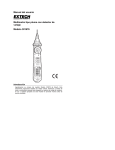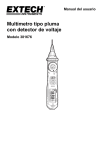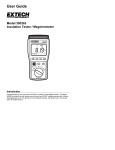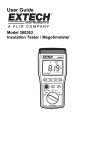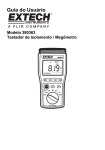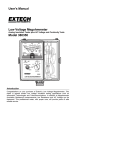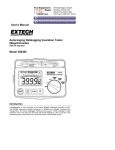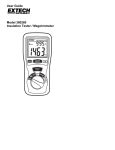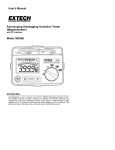Download Craftsman 82354 Owner`s manual
Transcript
Owner's Manual Pen Multimeter with Voltage Detector Model No. 82354 CAUTION: Read, understand and follow Safety Rules and Operating Instructions in this manual before using this product. • Safety • Operation • Maintenance • Español © Sears, Roebuck and Co., Hoffman Estates, IL 60179 U.S.A. www.craftsman.com 063006 TABLE OF CONTENTS Warranty Page 3 Safety Instructions 4 Safety Symbols 5 Control and Jacks 6 Symbols and Annunciators 6 Specifications 7 Battery Installation 8 Operating Instructions 9 Non-Contact AC Voltage Detector 10 AC Voltage Measurements 10 DC Voltage Measurements 10 Resistance Measurements 11 Continuity Measurements 11 Diode Test 12 Data Hold 12 MAX Hold 12 Function Button 12 Range Button 12 Auto Power Off 12 Maintenance 13 Battery Replacement 14 Troubleshooting 15 Service and Parts 15 2 ONE YEAR FULL WARRANTY ONE YEAR FULL WARRANTY ON CRAFTSMAN PEN MULTIMETER with VOLTAGE DETECTOR If this CRAFTSMAN Pen Multimeter fails to give complete satisfaction within one year from the date of purchase, RETURN IT TO THE NEAREST SEARS STORE OR OTHER CRAFTSMAN OUTLET IN THE UNITED STATES, and Sears will replace it, free of charge. This warranty gives you specific legal rights, and you may also have other rights which vary from state to state. Sears, Roebuck and Co., Dept. 817WA, Hoffman Estates, IL 60179 For Customer Assistance Call 9am - 5pm (ET) Monday through Friday 1-888-326-1006 WARNING: USE EXTREME CAUTION IN THE USE OF THIS DEVICE. Improper use of this device can result in injury or death. Follow all safeguards suggested in this manual in addition to the normal safety precautions used in working with electrical circuits. DO NOT service this device if you are not qualified to do so. 3 SAFETY INSTRUCTIONS This meter has been designed for safe use, but must be operated with caution. The rules listed below must be carefully followed for safe operation. 1. NEVER apply voltage to the meter that exceeds the specified maximum: Input Limits Function V DC or V AC Resistance, Diode Test, Continuity Maximum Input 600V DC/AC, 250Vrms on 200mV range 250Vrms DC/AC 2. USE EXTREME CAUTION when working with high voltages 3. DO NOT measure voltage if the voltage on the "COM" input jack exceeds 600V above earth ground 4. Always use caution when working with voltages above 60VDC or 30VACrms. Keep fingers behind probe barrier when taking measurements. 5. When taking non-contact voltage measurements ensure that the positive test lead is NOT exposed and that the negative (common) test lead is not connected to the bottom of the meter. 6. NEVER connect the meter leads across a voltage source while the function switch is in the resistance or diode mode. Doing so can damage the meter 7. ALWAYS turn off the power and disconnect the test leads before opening the cover to replace the battery 8. NEVER operate the meter unless the back cover is in place and fastened securely 4 SAFETY SYMBOLS This symbol adjacent to another symbol, terminal or operating device indicates that the operator must refer to an explanation in the Operating Instructions to avoid personal injury or damage to the meter. MAX 600V This symbol advises the user that the terminal(s) so marked must not be connected to a circuit point at which the voltage with respect to earth ground exceeds (in this case) 600 VAC or VDC. This symbol adjacent to one or more terminals identifies them as being associated with ranges that may, in normal use, be subjected to particularly hazardous voltages. For maximum safety, the meter and its test leads should not be handled when these terminals are energized. This symbol indicates that a device is protected throughout by double insulation or reinforced insulation. 5 CONTROLS AND JACKS 1. Retractive positive test lead 2. Test Lead retracting nut 3. AC voltage detector and warning Light 4. Finger protection barrier 5. Rotary function dial 6. Sensitivity adjustment for AC voltage detector 7. RANGE button 8. FUNCTION button 9. MAX HOLD button 10. DATA HOLD button 11. COM input jack 12. LCD display Note: The battery compartment is located on rear of unit. 1 2 3 4 5 7 8 9 10 12 11 SYMBOLS AND ANNUNCIATORS •))) Audible Continuity V Volts Diode function Ω Ohms Data Hold Low battery D.H m milli (10-3) (volts) DC Direct current k kilo (103) ohms AC Alternating current M Meg (106) ohms M.H Maximum Hold 6 6 SPECIFICATIONS Range 50 to 600V Resolution NA 200mV 2.000V 20V 200V 600V AC Voltage 200mV (V AC) 2.000V (40-400Hz) 20V 200V 600V Resistance 200Ω (open circuit 2kΩ voltage: 20kΩ 0.25V) 200kΩ 2MΩ 20MΩ 0.1mV 1mV 0.01V 0.1V 1V 0.1V 1mV 0.01V 0.1V 1V 0.1Ω 0.001kΩ 0.01kΩ 0.1kΩ 0.001MΩ 0.01MΩ Function Non-contact AC voltage detector DC Voltage (V DC) Accuracy ±(0.7% reading + 2 digits) ±(0.8% reading +3 digits ±(1.0% reading +3 digits ±(1.0% reading +3 digits) ±(1.0% reading +1 digit) ±(1.0% reading +5 digits) NOTE: Accuracy specifications consist of two elements: • (% reading) – This is the accuracy of the measurement circuit. • (+ digits) – This is the accuracy of the analog to digital converter. o o o o NOTE: Accuracy is stated at 65 F to 83 F (18 C to 28 C) and less than 75% RH. Diode Test: Forward DC bias Current: 1mA approx.; Reverse DC bias voltage: 1.5V approx. Overload protection: 250VDC or ACrms Continuity Check Audible signal will sound if the resistance is less than 50Ω Open circuit voltage: 0.5V; Overload protection: 250VDC or AC Display 2000 count (0 to 1999) LCD Input Impedance 10MΩ , AC & DC Voltage Over-range indication ‘OL’ is displayed Auto Power Off After 15 minutes (approx.) of inactivity 7 Polarity Automatic (no indication for positive readings) Minus (-) sign for negative readings. Measurement Rate 2 times per second, nominal Low Battery Indicator “ ” is displayed to alert battery replacement Batteries Two (2) 1.5V ‘AAA’ batteries Operating Temperature 41ºF to 104ºF (5ºC to 40ºC) o o o o Storage Temperature -4 F to 140 F (-20 C to 60 C) Operating Humidity Max 80% up to 87ºF (31ºC) decreasing linearly to 50% at 104ºF(40ºC) Storage Humidity <80% Operating Altitude 6560ft. (2000meters) operating Weight / Size 3.9oz (110g) / 8.2 x 1.5 x 1.1“(208 x 38 x 29mm) Safety For indoor use and in accordance with the requirements for double insulation to IEC1010-1 (1995): EN61010-1 (1995) Overvoltage Category III, Pollution Degree 2. BATTERY INSTALLATION WARNING: To avoid electric shock, disconnect the test leads from any source of voltage before removing the battery cover. 1. 2. 3. 4. Turn the FUNCTION dial to the OFF position. Disconnect the negative (common) test lead from the meter. Fully retract the positive test lead probe. Remove the rear battery cover by removing the Phillips head screw at the rear center of the meter housing. 5. Insert two 1.5V ‘AAA’ batteries observing the correct polarity. 6. Put the battery cover back in place and secure with the screw. WARNING: To avoid electric shock, do not operate the meter until the battery cover is in place and fastened securely. NOTE: If your meter does not work properly, check the fuses and battery to make sure that they are still good and that they are properly inserted. 8 OPERATING INSTRUCTIONS WARNING: Risk of electrocution. High-voltage circuits, both AC and DC, are very dangerous and should be measured with great care. NOTE: On some low AC and DC voltage ranges, with the test leads not connected to a device, the display may show a random, changing reading. This is normal and is caused by the high-input sensitivity. The reading will stabilize and give a proper measurement when connected to a circuit. NOTE: The supplied black test leads (standard test lead and alligator clip probe) have protective plugs that must be removed before being inserted in the bottom of the meter. The protective apparatus must be removed from the end of the lead that plugs into the meter. NON-CONTACT AC VOLTAGE DETECTOR WARNING: Test the AC voltage detector on a known live circuit before each use. WARNING: Before using the meter in the AC Voltage Detector mode, verify that the batteries are fresh by confirming characters appear on the LCD when the function dial is turned to the voltage (V) position. Do not attempt to use the meter as an AC Voltage Detector if the batteries are weak or bad. With the function switch set to the NCV position, this instrument can detect the presence of AC voltage (from 50 to 600VAC) simply by being held very near to a voltage source. The NCV function works when the meter’s function dial is placed in the NCV position only. 1. Ensure that the retractable test lead is fully retracted. 2. Disconnect the common (negative) test lead from the bottom of the meter. 3. Put the function switch to NCV position. 4. Test the detector on a known live circuit. 5. Hold the top of the meter very close to the voltage source as shown. 6. Adjust the sensitivity dial to the highest sensitivity position (fully counter-clockwise) and then lower the sensitivity as required. 7. If voltage is present, the light at the top of the meter will flash and the alarm will sound. 9 AC VOLTAGE MEASUREMENTS WARNING: Risk of Electrocution. The probe tips may not be long enough to contact the live parts inside some 240V outlets for appliances because the contacts are recessed deep in the outlets. As a result, the reading may show 0 volts when the outlet actually has voltage present. Make sure the probe tips are touching the metal contacts inside the outlet before assuming that no voltage is present. CAUTION: Do not measure AC voltage if a motor on the circuit is being switched ON or OFF. Large surges may occur that can damage the meter. 1. Set the function dial to the V position. 2. Use the FUNC button to select AC. 3. Insert the black test lead banana plug into the negative jack at the bottom of the meter. 4. Unscrew the retracting nut (clockwise) to draw out the positive test lead. 5. Touch the black test probe tip to the neutral side of the circuit. 6. Touch the positive test probe tip to the “hot” side of circuit. 7. Read the voltage on the display. The meter automatically selects the optimum range or the user may manually select a range using the RANGE button. DC VOLTAGE MEASUREMENTS CAUTION: Do not measure DC voltages if a motor on the circuit is being switched ON or OFF. Large voltage surges may occur that can damage the meter. 1. Set the function dial to the V position. 2. Use the FUNC button to select DC. 3. Insert the black test lead banana plug into the negative jack at the bottom of the meter. 4. Carefully turn the positive test lead retracting nut (located at the top of the meter) clockwise to completely draw out the positive test lead probe. 5. Touch the black test probe tip to the negative side of the circuit. 6. Touch the positive test probe tip to the positive side of the circuit. 7. Read the voltage on the display. The meter automatically selects the optimum range or the user may manually select a range using the RANGE button. 10 RESISTANCE MEASUREMENTS WARNING: To avoid electric shock, disconnect power to the unit under test and discharge all capacitors before taking any resistance measurements. 1. Set the function switch to the Ω 2. 3. Use the FUNC button to select the resistance mode Ω. Insert the black test lead banana plug into the negative jack at the bottom of the meter. Carefully turn the test lead retracting nut (located at the top of the meter) clockwise to completely draw out the positive test lead probe. Touch the test probe tips across the circuit or part under test. It is best to disconnect one side of the part under test from the circuit so the rest of the circuit will not interfere with the resistance reading. Read the resistance on the display. The meter automatically selects the optimum range or the user may manually select a range using the RANGE button. 4. 5. 6. position. AUDIBLE CONTINUITY CHECK WARNING: To avoid electric shock, never measure continuity on circuits that have a voltage potential. 1. 2. 3. 4. 5. 6. Set the function switch to the Ω position. Use the FUNC button to select the audible continuity mode Insert the black test lead banana plug into the negative jack at the bottom of the meter. Carefully turn the test lead retracting nut (located at the top of the meter) clockwise to completely draw out the positive test lead probe. Touch the test probe tips to the circuit or wire under test. If the resistance is less than approximately 50Ω, the audible tone will sound. If the circuit is open, the display will indicate “OL”. 11 DIODE TEST 1. 2. 3. 4. 5. 6. 7. Set the function switch to the Ω position. Use the FUNC button to select the diode function Insert the black test lead banana plug into the negative (common) jack at the bottom of the meter. Carefully turn the test lead retracting nut (located at the top of the meter) clockwise to completely draw out the positive test lead probe. Touch the test probes to the diode under test. A good diode will indicate approx. 0.3V (germanium diodes) to 0.7V (silicon diodes) for the forward test and “OL” for the reverse test. A shorted diode will indicate the same value of voltage in both the reverse and forward test directions. An open diode will indicate “OL” in both test directions. DATA HOLD Button To freeze a displayed reading, press the DATA H button. The reading will freeze and the D.H display icon will be visible on the LCD. To release the display, press the DATA H button again. The DH indicator will switch off and the display will again show real time readings. MAXIMUM HOLD Button To display only the highest reading, press the MAX H button. The M.H display icon will be visible on the display while in the Max Hold mode. Now, the display will only change when a higher reading than the displayed reading is encountered. To return to normal operation, press the MAX H button again (the MH display icon will switch off). FUNC (Function) BUTTON The FUNC (function) button is used to select AC or DC while in the VOLTAGE (V) mode. The FUNC button is also used to select diode Continuity , or Resistance Ω while in the Ω mode. , RANGE Button The meter automatically selects the optimum range; however, the meter’s ranges can be selected manually. When using the RANGE button to manually select a range, start with the highest range and then select successively lower ranges until the desired range is reached. The decimal place will move with each press of the RANGE button. Automatic Power OFF The meter is equipped with an automatic power off feature to preserve battery energy. After 15 minutes of inactivity, the meter will automatically turn off. To turn the meter on again, simply rotate the function switch to the desired function. 12 MAINTENANCE WARNING: To avoid electric shock, disconnect the test leads from any source of voltage before removing the back cover or the battery cover. WARNING: To avoid electric shock, do not operate your meter until the battery cover is in place and fastened securely. This multimeter is designed to provide years of dependable service, if the following care instructions are performed: 1. KEEP THE METER DRY. If it gets wet, wipe it off. 2. USE AND STORE THE METER IN NORMAL TEMPERATURES. Temperature extremes can shorten the life of the electronic parts and distort or melt plastic parts. 3. HANDLE THE METER GENTLY AND CAREFULLY. Dropping it can damage the electronic parts or the case. 4. KEEP THE METER CLEAN. Wipe the case occasionally with a damp cloth. DO NOT use chemicals, cleaning solvents, or detergents. 5. USE ONLY A FRESH BATTERY OF THE RECOMMENDED SIZE AND TYPE. Remove the old or weak battery so it does not leak and damage the unit. 6. IF THE METER IS TO BE STORED FOR A LONG PERIOD OF TIME, the battery should be removed to prevent damage to the unit. 13 BATTERY REPLACEMENT WARNING: To avoid electric shock, disconnect the test leads from any source of voltage before removing the battery cover. 1. 2. 3. 4. 5. 6. 7. 8. The icon will appear when battery voltage is low. Turn the Function dial to the OFF position. Disconnect the negative (common) test lead from the meter. Fully retract the positive test lead probe. Remove the Phillips head screw at the rear center of the meter housing. Remove the battery compartment cover to access the batteries. Replace the two (2) 1.5V ‘AAA’ batteries observing polarity. Secure the battery compartment cover. WARNING: To avoid electric shock, do not operate your meter until the rear battery cover is in place and fastened securely. UL LISTED The UL mark does not indicate that this product has been evaluated for the accuracy of its readings. 14 TROUBLESHOOTING There may be times when your meter does not operate properly. Here are some common problems that you may have and some easy solutions to them. Meter Does Not Operate: 1. Always read all the instructions in this manual before use. 2. Check to be sure the battery is properly installed. 3. Check to be sure the battery is good. If You Do Not Understand How the Meter Works: 1. Purchase “Multitesters and Their Use for Electrical Testing”, (Item No. 82303). 2. Call our Customer Service Line 1-888-326-1006. SERVICE AND PARTS Item Number Description 82354-L Black Test Lead 82354-D Replacement battery cover 82354-CS Rear cover screws For replacement parts shipped directly to your home Call 9 am – 5 pm eastern, M - F 1-888-326-1006 15
















